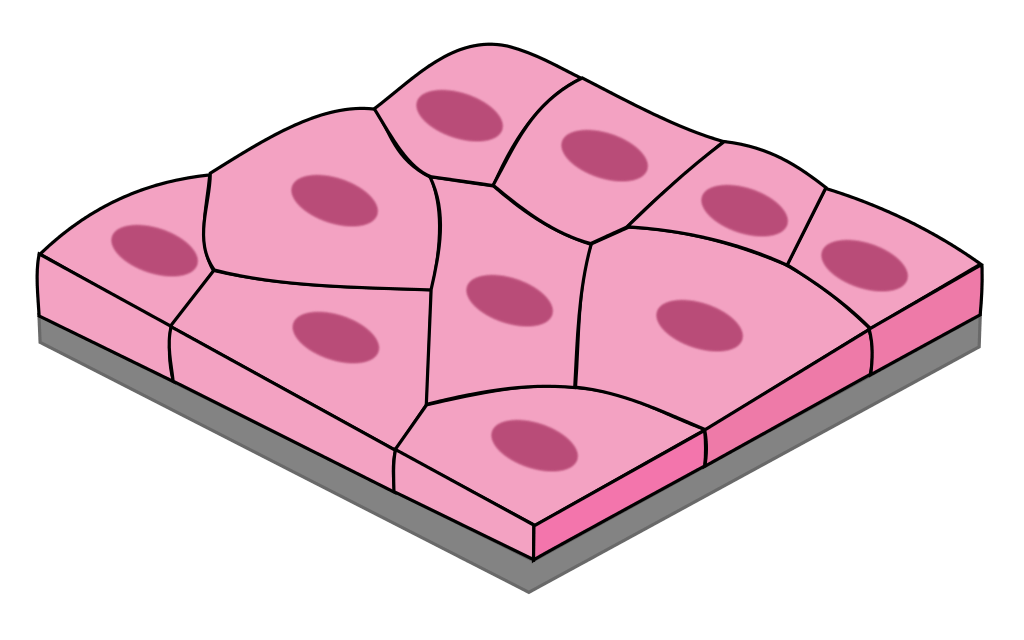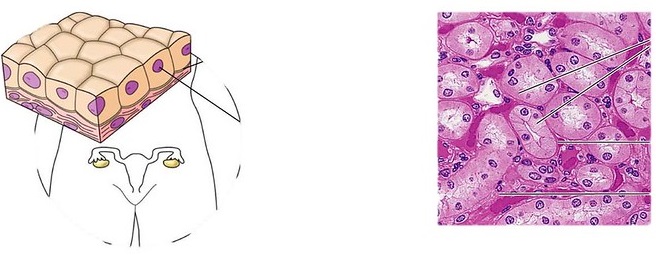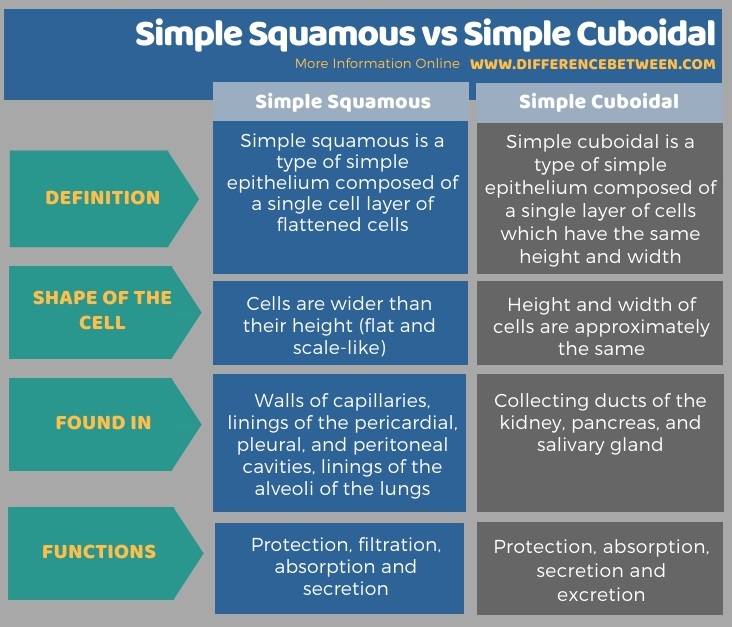The key difference between simple squamous and simple cuboidal is that simple squamous tissue is composed of a single layer of flat polygonal or hexagonal shaped cells while simple cuboidal tissue is composed of a single layer of cuboidal shaped cells with the same height and width.
The epithelium is one of the four types of tissue that lines our body surfaces and internal and external surfaces of body organs. There are two main types of epithelial tissue based on the number of cell layers. They are simple epithelium and compound or stratified epithelium. As the name suggests, the simple epithelium has one cell layer. Hence, all the cells of the simple epithelium are attached to the basement membrane. Simple epithelial tissue can be seen in the lining of the blood vessels, alveoli, pericardium, kidney tubules, pancreas, glands, stomach, small intestine, trachea, airways and nose. Simple epithelium mainly fulfils functions such as absorption, secretion and filtration. Based on the shapes of the cells, the simple epithelium has four types as simple squamous epithelium, simple cuboidal epithelium, simple columnar epithelium and pseudo-stratified epithelium.
CONTENTS
1. Overview and Key Difference
2. What is Simple Squamous
3. What is Simple Cuboidal
4. Similarities Between Simple Squamous and Simple Cuboidal
5. Side by Side Comparison – Simple Squamous vs Simple Cuboidal in Tabular Form
6. Summary
What is Simple Squamous?
Simple squamous epithelial tissue is composed of a single layer of flat polygonal or hexagonal shaped cells. Each cell has a centrally located, spherical nucleus and irregular boundaries.

Figure 01: Simple Squamous
Moreover, this tissue is distributed in the lining of the heart, alveoli, bowman’s capsule, visceral and peritoneal lining of the coelom. Also, its main functions are protection, filtration, absorption and secretion.
What is Simple Cuboidal?
Simple cuboidal tissue is composed of a single layer of cuboidal shaped cells with the same height and width. Furthermore, this tissue is distributed in the ducts and glands, which include pancreatic ducts and salivary glands. It is also distributed along the renal tubule.

Figure 02: Simple Cuboidal
Moreover, simple cuboidal epithelial cells can also be lined with microvilli which will facilitate the function of absorption. General functions are protection, absorption, secretion and excretion.
What are the Similarities Between Simple Squamous and Simple Cuboidal?
- Simple squamous and simple cuboidal epithelia are two types of simple epithelial tissues which have one cell layer.
- All the cells of both epithelia are attached to the basement membrane.
- They carry out functions such as protection, absorption, secretion.
What is the Difference Between Simple Squamous and Simple Cuboidal?
Simple squamous is a type of simple epithelium composed of a single cell layer of flattened cells, while simple cuboidal is a type of simple epithelium composed of a single layer of cells which have the same height and width. So, this is the key difference between simple squamous and simple cuboidal.
Moreover, the simple squamous epithelium is found in walls of capillaries, linings of the pericardial, pleural, and peritoneal cavities, linings of the alveoli of the lungs. Meanwhile, the simple cuboidal epithelium is found in collecting ducts of the kidney, pancreas, and salivary gland. Also, protection, filtration, absorption and secretion are the functions of simple squamous epithelium. Meanwhile, protection, absorption, secretion and excretion are the functions of simple cuboidal epithelium.
Below infographic summarizes the difference between simple squamous and simple cuboidal.

Summary – Simple Squamous vs Simple Cuboidal
Simple squamous and simple cuboidal are two types of simple epithelial tissues. Both are composed of a single cell layer. Simple squamous tissue cells are wide and flat cells. In contrast, simple cuboidal tissue cells have the same width and height. Simple squamous tissue is found in walls of capillaries, linings of the pericardial, pleural, and peritoneal cavities, linings of the alveoli of the lungs while simple cuboidal tissue is found in pancreatic ducts and salivary glands. So, this summarizes the difference between simple squamous and simple cuboidal.
Reference:
1. “Epithelial Tissue.” Boundless Anatomy and Physiology, Lumen, Available here.
2. “Epithelium.” Wikipedia, Wikimedia Foundation, 21 Mar. 2020, Available here.
Image Courtesy:
1. “Simple squamous epithelium” By Kamil Danak – Own work (CC BY-SA 3.0) via Commons Wikimedia
2. “Simple cuboidal” By Brittany (CC BY 2.0) via Flickr
ncG1vNJzZmivp6x7pbXFn5yrnZ6YsqOx07CcnqZemLyue8OinZ%2Bdopq7pLGMm5ytr5Wau26%2FyKanpZ1dqL62rcyorKxlkaOxbr%2FIpqelnV2YwqO7yJ2YpWc%3D